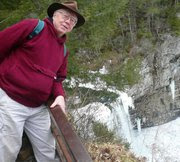Sunday, May 16, 2010
SIGRID UNDSET: GREATEST WOMAN WRITER
How’s that for a colossal assertion? As I return to blogging, I want to do it in a big way. The great writers: Homer, Virgil, Shakespeare, Cervantes, Dostoevsky, Tolstoy—and Sigrid Undset. For many readers, this will have the effect of introducing an unfamiliar name among the acknowledged greats. So be it. Find me another woman writer who belongs in the list I’ve given. I’m waiting.
As I ponder writing an essay on Sigrid Undset’s novels for a Catholic publication, I find myself in utter awe of the achievement of Sigrid Undset, and confounded by what to say. She has been compared to Shakespeare, and rightly, but the visions and even the styles of all great writers converge for me. I can imagine Kristin Lavransdatter walking into The Brothers Karamazov or Hamlet drawing his sword or axe in the violent scenes of Undset’s north.
May 20, 1882-June 10, 1949. So it’s Sigrid’s birthday this week, and that is why I have chosen to return to my blog just now. Her life spans the period in which J.R.R. Tolkien lived, the period in which the West moved from the last days of agrarian culture to the nuclear age. Like Tolkien, Undset realized early in life that writing about modern times would not say to moderns what needs to be said. While Tolkien imagined a world that is, and is not, our own, he also realized through his vision the moral and spiritual war of good and evil. Both Tolkien and Undset quite simply turned their backs on the modern bleakness and sterility other twentieth century writers either depicted with disdain or tried to combat through various literary strategies, and reached into their Catholic heritage to draw us into distinctively Catholic visions of God, man, nature, and society.
Both found their visions by making stories of other times. If you do not know anything about Sigrid Undset, start by reading the Wikipedia article on her. It’s not bad, and it will point you to, well, reading her books. This week a friend pointed me to a passage in Dorothy Day’s diaries (Dorothy Day of the Catholic Worker movement) in which she recounted her reading of Undset’s Kristin Lavransdatter. She spoke of others reading Undset’s novels and being so entranced they left behind housework and other things. That was my experience. I read Undset first in the 1970’s, and I have been returning ever since.
While Tolkien made another world altogether, Undset chose to write of medieval Norway. Her two major works are Kristin Lavransdatter, a trilogy, and The Master of Hestviken, a tetralogy. For these Undset was awarded the Nobel Prize for Literature in 1928, the third woman to achieve that once-important distinction. I suspect there is no way that she could win that prize now, for her Catholic vision is black holes away from where the decadent literati of the post-West sport now.
Undset’s writing is not like the sentimental or decadent historical romances that now burgeon on our bookstore bookshelves. From the time you begin to read of young Kristin, you will feel and know that that world is as close to you as sin and redemption, holiness and decadence, and all the joys and sorrows of your life—but set in a world in which both joy and sorrow are taken seriously and loved as if everything matters. Sin, crime, violence, war, political intrigue, homosexuality, pedophilia, corruption: they are all there, vivid and present in a constant sense of the urgency of human choice, but it is all against the background of an orthodox world in a struggle against paganism and the willful sins of men—and women.
If you are a young person of any age, order Tiina Nunnally’s translation of Kristin Lavransdatter (Penguin) and settle in for a summer of delight and truth, or rather delight in truth, for Undset fulfills the task of all great writers in making a story that calls “young children from their play and old men from their chimney corner” (Sir Philip Sidney, “Apology for Poetry”). In just a few pages you will be entranced, and by the end of the third volume, you will—I think—be touched and changed.
When the Nazis invaded Norway in World War II, one of the targets on their list of intellectual enemies was Sigrid Undset, who had written and spoken bravely of their evils. As the Nazis advanced, Sigrid fastened on the skis she had often portrayed in her stories and fled into neutral Sweden, from which she made her way to New York where she lived until the end of the war. Then, exhausted, she returned to her home, which had been plundered and trashed by the Nazi high command, and wrote no more. No matter. We have two of the greatest stories ever made. Read, and lead others, especially young people, to read. That is one of the great things we can do to restore sanity.
Subscribe to:
Comments (Atom)



